This article accompanied part two of a five part radio series. To listen, visit WFDD's website.
Manu National Park in southern Peru is known as the most biologically diverse place on earth. It’s also a perfect laboratory for scientists to study the impact of global warming on tropical forests.
Miles Silman, a biology professor from Wake Forest University, started coming to these forests 23 years ago as a graduate student at Duke. Initially, he was interested in the mechanics of how forests work as a unified system — trees, plants and wildlife. Global warming made him shift his focus. Ten years ago, he co-founded the Andes Biodiversity and Ecosystem Research Group with top tropical biologists from the United Kingdom, the United States and Peru. He then undertook the physically demanding task of marking off eight 100-meter-square research plots down a steep gradient of the Andes.
“The only way of getting effective information was to put in those plots," he says. "It forces you to look at every tree and then you also start to get an understanding of the dynamics of the forest. I was mainly about biodiversity and distribution. A lot of it was motivated by looking at the Paleo record and realizing we know more about what happened on these slopes 50,000 years ago then we do today.”
What happened 50,000 years ago is that tree and plant species migrated up and down the slopes of the Andes in response to Ice Ages and the warming that followed. They moved to stay in their very narrow temperature sweet spots. This movement enabled them to avoid extinction.
About five years after Silman installed his research plots, tropical biologist Ken Feeley decided to see if the existing species in the Amazon basin were on the move. Feeley studied as a post-doc under Silman and is now a professor at Florida International University in Miami. Silman says he thought Feeley's project was a fool's errand, because their plot census was not even 5 years old, but Silman says when they looked at the data, they saw that the trees were indeed moving up.
Feeley's pioneering research established for the first time that tropical species are in fact migrating upslope. That ability to adapt is a good thing. But Feeley and Silman quickly saw problems. During the last Ice Age, species had thousands of years to adapt. Today, because temperatures are rising faster, they have only decades to reproduce upslope. And none is keeping pace. Also, the treeline above 12,000 feet doesn’t appear to be moving at all. It’s a scenario that fills Silman with dread.
"The trees are moving up, but the treeline is not moving up," he says. "And so there is this collision that’s happening. The more and more warming you get, the trees farther and farther down will get pushed up against this barrier, and they’ve got no place to go. So they will reduce their population sizes, and if this happens over large areas, it could drive some species extinct. And it could reduce the population sizes of many, many species."
Scientists say the potential loss of those species in the next 50 to 75 years could dramatically reshape life as we know it. It’s not just about trees and plants dying off. Tropical forests are the functional lungs of the earth. They play a vital role in the water cycle and regulating weather around the world.























